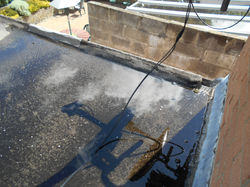
DEFECTIVE RAINWATER GOODS
Most modern rainwater goods are of PVC type and whilst they are resistant to corrosion defects can still arise. As PVC is vulnerable to thermal movement the gutters and downpipes can often expand and contract during fluctuations in heat, this can result in joints opening and the rubber seals to become dislodged. Over time the rubber seals can also perish. Staining at the underside of joints to gutters or at the junction of gutters and downpipes is an indication of defective joints.
Some older properties may still have cast iron type rainwater goods in place and it is not uncommon to find PVC type gutter connected into cast iron downpipes and vice versa. Cast iron rain water goods are vulnerable to corrosion and if these are not painted on a regular basis corrosion can occur. Issue will often arise. In order to properly maintain cast iron downpipes they must be removed from the wall for repainting, often this is not the case and corrosion can often occur at the back of downpipes which have remained unpainted for several years.
Poorly designed rainwater goods layouts can often result in problems. Gutters will overflow if they do not have sufficient capacity to cope with the volume of water discharged from the roofs. This scenario can occur where gutters to a higher roof discharge into downpipes which discharge onto a lower roof. The gutters to the lower roof must have sufficient capacity to deal with not only the water discharged from the lower roof but also from the higher roof. If this is not the case the lower gutter will overflow leading to further issues.
Blocked or backed up gutters is one of the most common issues flagged up on property surveys. Gutters can often become blocked with leaves, sediment and items causing water to back up and over flow, saturating the joinery and wall below.
Overflowing gutters can lead to saturation of the walls below. This can be a distinct problem in older properties with solid masonry type walls. When a solid wall becomes saturated dampness will penetrate internally causing damage to the internal finishes and can lead to further defects such as timber decay. Externally the saturated wall is vulnerable to frost damage, resulting in debonded plaster or spalled brickwork and damaged pointing. Frost attack will increase the permeability of the wall leading to further penetrating damp. Something as innocuous as a tennis ball can cause extensive damage both internally and externally.
Defective valley and box gutters can often cause problems. Poorly detailing and workmanship to the gutter linings can result in water ingress into the roof space particularly if the breather membrane or sarking felt is defective. Water ingress can lead to rot developing to the structural timbers and if left un-checked can comprise the load bearing capabilities of the timbers.
Standing water in backed up parapet gutter
Defective rain water goods causing rot to timber fasca and soffits
 DSCN9737 |  DSCN7913 |
|---|---|
 DSCN8311 |
Ponding water on flat roof as a result of a blocked outlet
If you are suffering with damp issues in your property one of our Chartered Surveyors are on hand to assist. We can provide a bespoke report detailing the cause of the defect and suggest appropriate remedial works. If you would like further information on the services we provide please do not hesitate to contact us.
